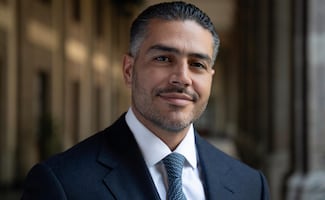Más Información

"Queremos cerrar este capítulo", dice Salinas Pliego al SAT; esperarán a enero a conocer fundamentos legales de adeudo fiscal

New York Times destaca rol de Harfuch en el combate del narco; resalta intercambio de inteligencia con EU

En operativo, cae secuestrador "El Chuleta" en Morelos; detienen a otros 38 generadores de violencia
Due to the National Guard’ s deployment in Mexico’s southern border to contain migrant flow and their impossibility to climb “La Bestia,” human traffickers have reactivated the sea route comprehended in the coasts of Chiapas and Oaxaca , which was no longer used because of the danger it represents trying to enter Mexican territory via open sea, according to migration authorities.
Last October 11 , there was a wreck on a boat in which allegedly 17 persons were traveling, out of which 11 were African . The accident, in which four people lost their lives and one is missing , revealed that the sea route has become, again, the migrant alternative to get to the United States .
Source of the Beta Group (Grupo Beta) , which belongs to the National Migration Institute (INM) , reported that during the rescue of the third body, fishermen from Oaxaca told them that in recent weeks, they have seen boats carrying people and sailing by the shore of the Pacific Ocean . This had also been noticed by Oaxaca’s Human Rights Ombudsman Institution.
According to African migrants’ testimonies collected by EL UNIVERSAL , traffickers charge from USD $1,600 to $1,900 for the sea journey. The boats sail early morning from different points of Madero Port , Chiapas , and are done in W25 boats , known as “shark boats.”
The vessels, overcrowded with up to 25 foreigners , travel over 300 km on the open sea, without the necessary security measurements and without considering the weather. In addition, they seek to arrive in towns in Oaxaca like Cachimbo or Aguchil , in San Francisco Ixhuatán , for fuel supply and to continue through Rancho Salinas, Trejo, Conchalito, Guadalupe, or Rincón Juárez , all of the fishing communities of the Santa María Tapanatepec municipality.
Some human traffickers arrive in Salina del Marqués or San Mateo and Santa María del Mar, and even to Huatulco, where there is less surveillance by authorities.
For priest Alejandro Solalinde Guerra , an activist for migrants’ rights, the wreck of Africans is the responsibility of human traffickers, who see migrants as goods and not as human beings. He commented that they are using the sea route again, which is dangerous and which was made from “corruption networks” many years ago.
He explained that migrants are trapped in two agendas: “The first is the one offered by Mexico’s government : staying in the country for a period of six months to prevent serious conflicts with the U.S. that affect the Mexican economy . The second is the risky alternative of using Oaxaca’s sea route .”
Prior deaths.
The wreck in which at least 4 Africans drowned last week is not the first in this deadly route.
Some years ago, fishermen from Chiapas and Oaxaca reported with regularity the wrecks of small boats with up to 30 people amidst the high tides caused by winds in the region.
In June 2000 , they caused the death of 23 Guatemalans in San Francisco: “A wave lifted the boat and sank it,” said a survivor. Seven years later, another boat with 17 migrants sank in the same area, killing 15.
Current deaths.
On the early morning of October 11 , two boats sailed from Madero Port . One wrecked at approximately 7:00 when it was close from Paredón and Arista Port. It is said that the engine got stuck in a fishnet and that the vessel was hit by a wave that threw migrants into the water.
The testimonies of the four survivors, originally from Cuba and Africa , who were helped by settlers of the Allende community, say that there were 17 foreigners in the vessel: eight of them surrendered to authorities, four continued their journey , and other four drowned and their bodies have already been rescued. There is only one person missing.
The first body rescued was that of Emmanuel Cheo NGU , originally from Cameroon . Hours later, the sea threw the body of another non-identified migrant . A third one appeared in the late afternoon of Saturday, October 12 , but it was rescued two days later, in the La Línea, Oaxaca , fishing community. Yesterday, a fourth body was located by the seashore of Agencia de Santa Cruz, in the San Mateo del Mar municipality.
Despite the wreck between Paredón and Arista Port, hours later another vessel with 20 migrants sailed from Madero Port. According to Cameroon citizens , despite the danger, they look to arrive in the U.S. to meet their relatives .
mp
Noticias según tus intereses
[Publicidad]
[Publicidad]
















